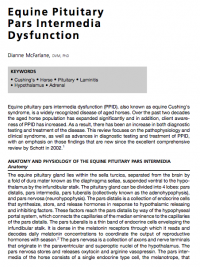Equine pituitary pars intermedia dysfunction (PPID), also known as equine Cushing's syndrome, is a widely recognized disease of aged horses. Over the past two decades, the aged horse population has expanded significantly and in addition, client awareness of PPID has increased. As a result, there has been an increase in both diagnostic testing and treatment of the disease. This review focuses on the pathophysiology and clinical syndrome, as well as advances in diagnostic testing and treatment of PPID, with an emphasis on those findings that are new since the excellent comprehensive review by Schott in 2002.
-
Anatomy and physiology of the equine pituitary pars intermedia
-
Anatomy
-
Physiology
-
-
Epidemiology
-
Pathophysiology
-
Clinical signs of PPID
-
Hirsutism
-
Muscle Atrophy
-
Laminitis
-
PU/PD
-
Hyperhidrosis
-
Abnormal Fat Distribution and Insulin Resistance
-
Opportunistic Infections and Immunosuppression
-
Behavioral Abnormalities
-
Reproductive Infertility
-
Neurologic Disease
-
Clinical Pathology
-
Diagnostic tests for PPID
-
Dexamethasone Suppression Test
-
Endogenous Plasma ACTH or α-MSH Concentration
-
TRH Stimulation Test
-
Combined Dexamethasone Suppression/TRH Stimulation Test
-
Domperidone Response Test
-
Serum Insulin Concentration
-
Cortisol Circadian Rhythm Loss
-
Urinary Cortisol/Creatinine Ratio
-
ACTH Stimulation Test
-
Advanced Imaging Modalities
-
Necropsy
-
Treatment
-
Summary
-
References

